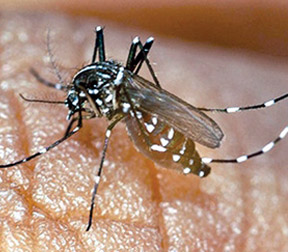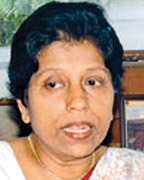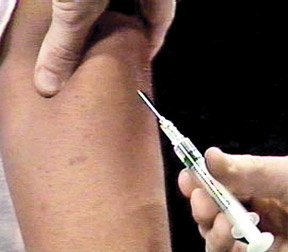Japanese Encephalitis on the wane in Ratnapura district
By Dhaneshi Yatawara
Inflammation of the brain
Encephalitis is an inflammation of the brain most commonly due to a
viral infection. In nature, the main resevoir of JE infection is not
human beings but various animals. Of these the most important is the
pig, which is considered to be an amplifier host.
This is because the virus is found at the highest levels for the
longest period (3-7 days) in the blood of the pig. Therefore, a mosquito
vector biting a pig has the greatest chance of getting infected. The
main vector is the culex mosquito. The JE virus does not produce any
illness in most of the animals infected, with the exception of
encephalitis in horses and abortion in pregnant pigs.
Isolation of Japanese Encephalitis virus
The virus was first isolated in Sri Lanka from a patient by at the
Medical Research Institute in 1968. According to historical records the
scientists had been Y.L. Hermon, M. Anandarajah as published in the
Ceylon Medical Journal (1974) under the topic 'Isolation of Japanese
Encephalitis virus from the serum of a child In Ceylon' In reference to
the above research Prof.
Tissa Vitharana in his MRI report says, “But its presence was
suspected earlier when a child died of encephalitis at the School for
the Blind at Mahawewa in June 1960.
One of the serum samples sent to the Virus Research Centre at Poona,
India was positive for group B arbovirus, probably Japanese
Encephalitis. ”
While Encephalitis occurred sporadically throughout the year in most
parts of the country, the first major outbreak occurred in the
Kurunegala district in 1971. This mainly affected children and in the
course of that year 76 cases were admitted to the children's ward at
Kurunegala Hospital. There was a high case fatality of 66 deaths and of
the 10 who survived 5 had residual neurological deficits.
Unfortunately, by the time the Medical Research Institute was
informed, it was too late to establish the cause of the outbreak. In
1971 a study was made of encephalitis cases admitted to the Children's
hospital, Colombo and District Hospital, Gampaha.
Of the 31 cases admitted to D H Gampaha (District Hospital), six were
serologically investigated at the MRI and one was found positive for JE.
Out of 50 cases at the Children's Hospital, four were serologically
investigated but there were no positives.
Source Report done by Prof. Tissa Vitharana when he was MRI Director
Live attenuated vaccines
Live attenuated vaccines are derived from disease-causing viruses or
bacteria that have been weakened under laboratory conditions. As it
further explains they will grow in a vaccinated individual, but because
they are weak, they will cause either no disease or only a mild form.
Usually, only one dose of this type of vaccine provides life-long
immunity, with the exception of oral polio vaccine, which requires
multiple doses.
Inactivated vaccines
Inactivated vaccines are produced by growing viruses or bacteria and
then inactivating them with heat or chemicals. Because they are not
alive, they cannot grow in a vaccinated individual and therefore cannot
cause the disease. They are not as effective as live vaccines, and
multiple doses are required for full protection. Booster doses are
needed to maintain immunity because protection by these vaccines
diminishes over time.
Serological survey
Cases occurred sporadically throughout the island and for the 10 year
period 1971 to 1980 there was an average of 1,030 hospital admissions
each year for encephalitis with a mean case fatality rate of 38 percent
(range of 25 percent - 45 percent). During this period etiological
studies done at the MRI on a limited number showed that Japanese
Encephalitis is the leading cause, accounting for 413 percent.
A serological survey done by us in 1976 and 1977 in various parts of
Sri Lanka indicated that Japanese Encephalitis occurred mainly in
certain parts of the country. These were the Western coastal belt
extending from Kalutara in the south up to Puttalam in the north and
inland for about 10-15 miles to include Gampaha. Domestic pig rearing is
common in this area and 83 percent of pigs tested had quite high levels
of HI and NT antibodies against JE.
The other areas affected were those with large rice fields and where
wild pigs occur such as the districts of Kurugenala, Anuradhapura,
Batticaloa and Tissamaharama. There was some JE activity in the Northern
Province as well. There was little or no JE in the hill country.
Source Report done by Prof. Tissa Vitharana when he was MRI Director
The outbreak of Japanese Encephalitis is reported to further decrease
in the Ratnapura district with only one patient suspected to have
Japanese Encephalitis, being admitted to the Rathnapura hospital last a
week before, according to Consultant Physician of the Rathnapura General
Hospital Dr. N. Sritharan.
 “Otherwise from March onwards we didn't have any new cases,” said Dr.
Sritharan. The outbreak started since last November and in January 2013
it was the peak in getting more and more numbers of patients with
symptoms suspected to be Japanese Encephalitis aka JE. “Majority of them
were adults from Kuruwita, Pelmedulla, Nivithigala, Kahawaththa areas in
the Ratnapura district. But by February the number of patients started
to decrease and by March no new JE case was reported,” Dr. Sritharan
said. “Otherwise from March onwards we didn't have any new cases,” said Dr.
Sritharan. The outbreak started since last November and in January 2013
it was the peak in getting more and more numbers of patients with
symptoms suspected to be Japanese Encephalitis aka JE. “Majority of them
were adults from Kuruwita, Pelmedulla, Nivithigala, Kahawaththa areas in
the Ratnapura district. But by February the number of patients started
to decrease and by March no new JE case was reported,” Dr. Sritharan
said.
According to Dr. Sritharan very old patients have died as they were
having other medical conditions.
As the Ratnapura General Hospital had all the facilities including a
CT scan we were able to treat the patients and manage the illness
efficiently. A neurologist was always available. So we were equipped
with all the facilities,” said Sritharan.
According to Dr. Sritharan no patient showed residual symptoms –
which means symptoms that would remain with the patient life time.
News reported in the recent past quoting the Ministry of Health
stated that out of the 52 patients suffering from fever reported from
Ratnapura, only eight were confirmed to be infected with Japanese
Encephalitis. As the news reported a statement issued by the ministry
indicated that the rest of the reported cases were of Viral Encephalitis
which is a common condition.
Accordingly seven of the patients who had contracted Japanese
Encephalitis were over forty eight years of age while the other patient
was a two month old infant.
Around 11 persons died and 48 JE cases detected by February 11 from
December last year to January this year, news reports stated quoting
Sabaragamuwa Provincial Council Additional Secretary Sunil Leelananda.
Under control
Many of the patients reported with JE had been above 45 years,
according to head of the Epidemiology Unit of the Ministry of Health Dr.
Paba Palihawadana.
“Vaccinating children at the age of nine months against JE has been
happening for a long period under the Expanded Program on Immunisation
(EPI),” said Dr. Palihawadana.
According to the data available with the Epidemiology Unit the JE
vaccine was introduced to high-risk areas in 1987 - 88. By this time the
primary immunisation against JE consists of three doses at an interval
of two – four weeks between the first and second doses and one year
between the second and third and a booster dose is given every four
years after the primary immunization, according to documents published
in the Epidemiology Unit website. By then the JE immunisation under the
EPI program was given to children below the age of ten years living in
identified high-risk areas.
With more effective vaccines coming in to performance in the Medical
field the Government took a different option later to adopt the live
vaccine for JE which is at present given to children at nine months of
age. According to Dr. Palihawadana in the special situation at Ratnapura
children up to ten years of age were given the JE vaccine during the
recent outbreak. “We didn't have to give to all children as many were
vaccinated at nine months. Those who were not vaccinated at that age
were given the recommended doses,” she said.
According to Dr. Palihawadana exceptions in the present EPI program
are made only in areas that will show signs of high risks of spreading
JE. In parts of the country that are not considered as high risk areas
these exceptions will not be implemented.
“Still 95 percent of the population depends on the Government
initiated National Immunisation program as vaccinating is very costly.
And it had been very successful in controlling many diseases that would
have crippled the population of the country,” she said.
According to survey done by the Epidemiology unit in Ratnapura to
find the nature the disease is spreading they found that many abandoned
gem mines and even paddy fields were dried up at that time of the year,
though these with collected water are conducive breeding grounds for the
vector mosquito. “Even in paddy fields water is not allowed to stagnate
for a long time. The farmers let fresh water come in to the paddy fields
from time to time. So paddy fields if properly maintained can avoid
becoming a breeding ground,” she said.
“The people who ran animal husbandries have vaccinated their pigs
except for very few cases where the animals were not vaccinated. But the
major part of the pig pens were properly vaccinated,” she said
explaining the findings of the Epidemiology unit.
“In general if people try to avoid creating spots where water retains
unnecessarily it will reduce breeding grounds for many such diseases,”
she said.
According to Professor Tissa Vitharana's report based on the research
in North Central and North Western provinces following 1985 JE outbreak
in Sri Lanka, if the water level in the rice fields is lowered to ground
level one day of the week then the mosquito larvae and pupae die. The
research was carried out when Professor Vitharana was the Director of
the Medical Research Institute. As the report further said, while this
is possible to do in large irrigation schemes with sufficient stored
water, it is not possible in smaller irrigation schemes. Preliminary
studies done at the MRI show that fish such as guppies are good feeders
on vector mosquito larvae. At the beginning of 1985 (January and
February), 32 cases of Encephalitis were warded at the Anuradhapura
Hospital.
“Commencing in November 1985 and extending to February 1986 there was
a major outbreak of JE involving the Anuradhapura and Chilaw districts.
In Anuradhapura there were 406 cases of Encephalitis with 76 deaths. An
unusual feature of this outbreak was that about 50 percent of the cases
occurred in the age group 20-50 years and there was a preponderance of
male patients. There were 106 cases with 17 deaths in Chilaw, but this
followed the classical pattern and mainly affected children,” the report
said.
A bigger epidemic of over 600 cases of J E occurred in the
Anuradhapura District at the end of 1987 and early 1988.
 |
 |
|
Dr. Omala Wimalaratne |
Dr. Paba Palihawadana |
Vaccination is the most effective method to control Japanese
Encephalitis and that is how Sri Lanka has been able to control the
situation, said, Consultant Virologist and Vaccinologist, Head of the
Department of rabies and vaccines of the Medical Research Institute
(MRI) Dr. Omala Wimalarathne.
The earlier vaccine type used in Sri Lanka, when it was introduced in
1988, was the purified inactive Nakayama strain vaccine produced in
mouse brain - which was first started in the North Western and North
Central Provinces and was gradually introduced to the other provinces in
a phased manner.
“Then subsequently we changed to the Beijing strain because that was
the strain which we found to be similar to the field strains and was
found to be more immunogenic,” she said. In 2009 in the government
sector, the live attenuated strain of vaccine SA-14-14-2 was introduced
for children on completion of one year of age.
The killed JE vaccine was very expensive and the recommendation
initially was to give four doses the cost for JE vaccine alone was going
beyond the other EPI vaccines which the Ministry of Health recommended
for other illnesses, according to Dr. Wimalaratne.
Vaccination compulsory
“With the killed mouse brain Nakayama strain that is used in Sri
Lanka 1 millilitre needed to be given to children above three years of
age and for those less than three years, 0.5 ml is given. Primary course
consists of two doses administered each given two weeks apart and a
booster dose given 1 year later,” she said.
|

The JE-vaccine being administered |
“At present the live vaccine is used under the Government vaccination
program for children at nine months of age who are given a dose of
0.5ml. No booster doses are recommended at the moment,” she said. “The
manufacturer information leaflet recommends giving a booster dose but as
for studies conducted in Sri Lanka, suggested that children given one
dose were having enough immunity. In Nepal such studies were done and
the results showed that even up to five years of age with one dose of JE
live vaccine the children have adequate protection against JE,” she
said.
According to Dr. Omala Wimalaratne it is only with continuous studies
in Sri Lanka that the need for a second dose will be determined.
Killed inactivated vaccine is the one used in the private sector at
present. The primary vaccination is given for children above one year.
As this is the killed mouse brain vaccine it is not recommended for
children less than one year though the live vaccine is given at nine
months of age which is given through the EPI program.
“I don’t understand why a lot of people have not vaccinated their
children because they are scared of the vaccine. Safety studies are done
on the vaccine - with the live vaccine as well as the killed vaccine.
And we have had very few minor adverse reactions that were reported. One
important thing is if the child has had convulsions during the past one
year and is on anticonvulsive treatment we do not recommend JE
vaccination.
And if it is a non progressive neurological disease like cerebral
palsy then you don't have to worry. It is only acute illnesses and
progressive neurological conditions where we do not recommend the JE
vaccination -whether it is live or killed. Other than that I don't see
any other problems in giving the JE vaccine,” Dr. Wimalarathne said. |



